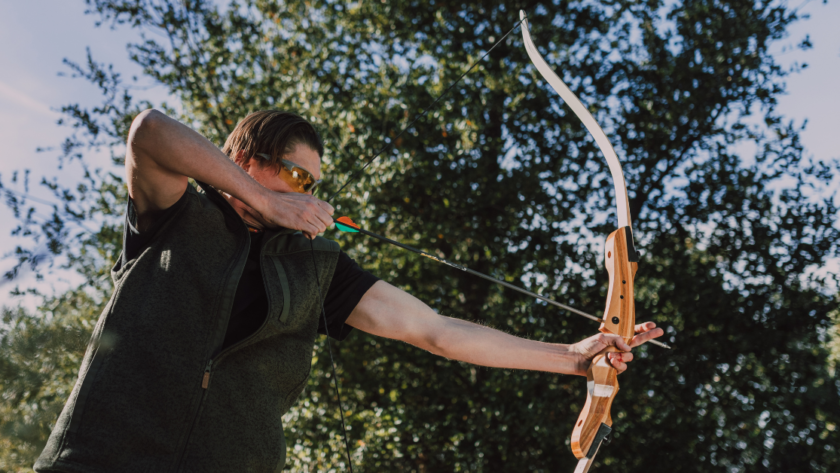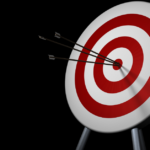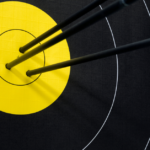The first time I picked up a recurve bow without sights, I felt a rush of excitement mixed with a healthy dose of uncertainty. There’s something primal and deeply satisfying about shooting a bow using only your instincts and skill.
But make no mistake – it’s a challenging art to master.
In this comprehensive guide, I’ll share everything I’ve learned about aiming a recurve bow without sights. We’ll cover the basic techniques, advanced strategies, and mental aspects that will help you become a proficient barebow archer.
Understanding the Fundamentals
Before we dive into specific aiming techniques, it’s crucial to build a solid foundation in archery basics. These fundamentals form the bedrock of your shooting technique and will support your progress as you develop your sightless shooting skills.
Proper Form: The Key to Consistency
Your stance, grip, anchor point, and release must be consistent for every shot. Think of your body as a finely tuned machine, where each part plays a vital role in the overall performance.
Stance: Start with your feet shoulder-width apart, perpendicular to the target. Your weight should be evenly distributed on both feet.
Grip: Hold the bow with a relaxed hand, allowing the bow to rest in the web between your thumb and index finger. Avoid gripping the bow tightly, as this can introduce torque and affect accuracy.
Anchor Point: Choose a consistent spot on your face where your drawing hand touches when at full draw. Common anchor points include the corner of your mouth, your cheekbone, or under your chin.
Release: Practice a smooth, clean release by relaxing your fingers and allowing the string to slip off naturally. Avoid plucking or jerking the string, as this can introduce inconsistencies in your shot.
To refine your form, practice in front of a mirror or record yourself shooting. This visual feedback will help you identify and fix any inconsistencies in your technique.
Eye Dominance: Your Natural Sight
Determining your dominant eye is crucial for accurate aiming. Close one eye at a time and see which feels more natural when focusing on the target.
Your dominant eye should be aligned with the arrow for the most intuitive aim.
To test your eye dominance:
- Form a small triangle with your hands by overlapping your thumbs and index fingers.
- With both eyes open, center a distant object in the triangle.
- Close your left eye.
If the object stays centered, you’re right-eye dominant.
If it moves out of the triangle, you’re left-eye dominant.
Draw Length: Finding Your Sweet Spot
A consistent draw length confirms that your anchor point and release are the same for every shot. To find your ideal draw length:
- Stand with your arms outstretched to the sides, forming a T-shape with your body.
- Have someone measure the distance from the tip of one middle finger to the other.
- Divide this measurement by 2.5 to get your approximate draw length.
Fine-tune this measurement by experimenting with slightly longer or shorter draws to find what feels most comfortable and natural for you. This will become your reference point for all future shots.
Anchor Point: Your Personal North Star
Establishing a reliable anchor point is critical for consistent shooting. Your anchor point serves as a reference for both your draw length and your aiming.
Common anchor points include:
- The corner of your mouth
- Your cheekbone
- Under your chin
- The side of your jaw
Whatever anchor point you choose, make it consistent and repeatable. Practice touching the same spot on your face with each draw until it becomes second nature.
Aiming Techniques: The Art of Sightless Shooting
Now that we’ve covered the basics, let’s explore the various techniques you can use to aim without sights.
1. Instinctive Shooting: Trusting Your Subconscious
Instinctive shooting relies on your body’s innate ability to align itself with the target. This method feels the most natural and fluid, but it needs extensive practice to master.
To develop your instinctive shooting skills:
- Focus intensely on the target, not on your arrow or bow.
- Draw and release in one fluid motion, trusting your body to make the necessary adjustments.
- Practice extensively to develop muscle memory and improve accuracy.
Instinctive shooting is similar to throwing a ball. You don’t consciously calculate the trajectory – your body just knows what to do.
The key is to practice consistently and trust in your natural abilities.
Start by shooting at large targets from close distances. As your accuracy improves, gradually increase the distance and decrease the target size.
Remember, consistency is key.
Try to maintain the same form, anchor point, and release for every shot.
2. Gap Shooting: Precision Through Reference
Gap shooting involves using the tip of your arrow as a reference point. This technique needs more conscious thought than instinctive shooting but can lead to incredible accuracy once mastered.
Here’s how to apply gap shooting:
- Aim the arrow tip above or below the target based on distance.
- Learn the “gap” between where you aim and where the arrow will hit at various distances.
- Use the arrow tip as your sight, adjusting it’s position relative to the target.
To develop your gap shooting skills, create a “gap chart” for different distances. Start by shooting at a target from various distances, noting where your arrow hits in relation to where you aimed. Over time, you’ll develop a mental map of how much to adjust your aim for different distances.
For example, you might find that at 20 yards, you need to aim the arrow tip 6 inches below the bullseye to hit the center. At 30 yards, you might need to aim directly at the bullseye.
These reference points will become your “sight” as you shoot.
3. String Walking: Fine-Tuning Your Vertical Aim
String walking is a technique that adjusts vertical aim by changing finger placement on the string. It’s a more advanced method but can lead to remarkable precision, especially in field archery where you encounter targets at varying distances.
To string walk effectively:
- Place your fingers at different positions on the string for different distances.
- Lower finger placement raises the arrow’s trajectory, and vice versa.
- Develop a consistent system for finger placement at various distances.
Start by finding your “point-on” distance – the distance at which you can aim directly at the target without adjusting your finger position. From there, experiment with moving your fingers up or down the string for different distances.
For closer targets, move your fingers down the string (away from the nock). This raises the arrow’s trajectory.
For farther targets, move your fingers up the string (closer to the nock) to lower the trajectory.
Keep a small notebook with you to record your finger positions for different distances. Over time, you’ll develop a precise system for adjusting your aim.
4. Face Walking: Adapting Your Anchor Point
Face walking involves changing your anchor point on your face for different distances. This technique can be combined with string walking for even greater precision.
To face walk:
- Use a higher anchor point for longer distances and a lower one for shorter distances.
- Combine with a consistent finger position on the string.
- Practice extensively to master different anchor points.
Face walking needs a high degree of body awareness and consistency. Start by establishing two or three distinct anchor points on your face.
For example, you might use the corner of your mouth for short distances, your cheekbone for medium distances, and under your chin for long distances.
Practice switching between these anchor points until you can do so consistently and comfortably. Remember to maintain the same draw length and release technique regardless of your anchor point.
Advanced Tips and Techniques
As you become more comfortable with these basic aiming methods, you can start to incorporate some advanced techniques to further improve your accuracy.
Developing Proprioception
Proprioception is your body’s ability to sense it’s position in space. By enhancing this sense, you can improve your consistency and accuracy in archery.
Try this exercise to develop your proprioception:
- Close your eyes and draw your bow.
- Focus on how your body feels at full draw.
- Release and try to maintain that feeling for your next shot.
- Repeat this process, paying attention to the position of your arms, shoulders, and back.
As you practice, you’ll develop a keen awareness of your body’s position during the shot. This awareness will help you maintain consistent form and improve your overall accuracy.
Achieving Proficiency at the Follow-Through
A proper follow-through is crucial for accuracy. After release, maintain your form until the arrow hits the target.
This confirms that you’re not introducing any last-second movements that could affect the arrow’s flight.
To practice your follow-through:
- Focus on keeping your bow arm steady after release.
- Maintain your anchor point until you hear the arrow hit the target.
- Pay attention to your release hand – it should move straight back along your jaw or neck.
A good follow-through shows that you’ve maintained proper form throughout the shot. If you find yourself dropping your bow arm or moving your head immediately after release, focus on holding your position for a few seconds longer.
Understanding Arrow Trajectory
Learning how arrow flight changes at different distances will help you make more accurate adjustments for varying target distances.
Factors that affect arrow trajectory include:
- Arrow speed
- Arrow weight
- Draw weight of the bow
- Wind conditions
- Elevation changes
Spend time observing how your arrows fly at different distances. Pay attention to the arc of the arrow and how it changes as you shoot farther or closer.
This knowledge will help you make more accurate adjustments when aiming.
Common Challenges and Solutions
Even experienced archers face challenges when shooting without sights. Here are some common issues and how to overcome them:
Inconsistent Anchor Points
Inconsistent anchor points can lead to erratic shooting and frustration. To address this issue:
- Use tactile references on your face to confirm consistency.
For example, touch your index finger to the corner of your mouth each time you draw.
- Practice drawing to your anchor point with your eyes closed, focusing on the feel of the position.
- Use a mirror to visually check your anchor point during practice sessions.
Target Panic
Target panic is a psychological condition where an archer experiences anxiety or loss of control when aiming. To overcome target panic:
- Implement blank bale shooting (shooting at a target with no defined bullseye) and focus on the process as opposed to the outcome.
- Practice relaxation techniques, such as deep breathing or visualization, before and during your shooting sessions.
- Break down your shot process into small, manageable steps and focus on executing each step perfectly.
- Consider working with a sports psychologist or experienced archery coach to develop coping strategies.
Wind Drift
Wind can significantly affect arrow flight, especially at longer distances. To compensate for wind drift:
- Learn to read wind indicators like grass or flags, and adjust your aim accordingly.
- Practice shooting in windy conditions to gain experience and develop a feel for how the wind affects your arrows.
- When possible, time your shots during lulls in the wind.
- For crosswinds, aim into the wind slightly to compensate for drift.
Maintaining Form
Consistent form is crucial for accurate shooting. To maintain good form:
- Regular practice and video analysis can help identify and fix form issues.
- Consider working with a coach to refine your technique.
- Use a training aid like a stretch band to practice your draw and anchor without the pressure of shooting.
- Focus on one aspect of your form at a time during practice sessions, rather than trying to fix everything at once.
Exercises to Improve Your Sightless Shooting
Incorporating specific exercises into your practice routine can significantly improve your sightless shooting skills. Here are some effective drills to try:
Blank Bale Shooting
Blank bale shooting involves shooting at a target with no defined bullseye, typically at close range. This exercise allows you to focus entirely on your form and shot execution without worrying about where the arrow lands.
To practice blank bale shooting:
- Set up a large target or hay bale at close range (5-10 yards).
- Shoot 10-20 arrows, focusing solely on your form, release, and follow-through.
- Pay attention to how each shot feels, rather than where it lands.
- Gradually increase the number of arrows as your endurance improves.
Distance Estimation
Accurate distance estimation is crucial for gap shooting and other aiming techniques. To improve your distance estimation skills:
- Set up targets at various unknown distances.
- Before shooting, estimate the distance to each target.
- Use a rangefinder to check your estimates.
- Shoot at the targets, noting how accurate your distance estimates were based on where your arrows land.
- Repeat this process regularly, gradually improving your ability to judge distances accurately.
Eyes-Closed Drawing
This exercise enhances your proprioception and helps develop a consistent draw and anchor point. To practice:
- Stand at your normal shooting position, but don’t nock an arrow.
- Close your eyes and draw your bow to your anchor point.
- Open your eyes and check your form and anchor point.
- Repeat this process 10-15 times, focusing on achieving the same position each time.
Single-Spot Focus
This drill improves your concentration and consistency. To practice:
- Set up a target with a small, single aiming point (like a small sticker or dot).
- Shoot 5-10 arrows, focusing intently on the single spot.
- Analyze your arrow grouping and adjust your aim as needed.
- Repeat the process, trying to tighten your groups with each round.
Mental Aspects of Barebow Archery
The mental game is just as important as the physical in barebow archery. Developing strong mental skills can significantly improve your performance and enjoyment of the sport.
Visualization
Visualization is a powerful tool for improving your shooting technique and building confidence. To practice visualization:
- Find a quiet, comfortable place to sit or lie down.
- Close your eyes and take a few deep breaths to relax.
- Imagine yourself at the shooting line, going through your entire shot process.
- Visualize every detail – the feel of the bow in your hand, the tension in the string, the moment of release, and the arrow flying true to the target.
- Practice this visualization technique regularly, especially before competitions or practice sessions.
Breathing Techniques
Controlled breathing can help manage stress and improve focus during shooting. Try this simple breathing exercise:
- As you prepare to shoot, take a deep breath in through your nose, filling your lungs completely.
- Hold the breath for a moment, then slowly exhale through your mouth.
- As you draw the bow, take another deep breath.
- Begin to exhale slowly as you aim, releasing the arrow at the natural end of your exhale.
Practice this breathing pattern until it becomes a natural part of your shot routine.
Positive Self-Talk
The way you talk to yourself can have a significant impact on your performance. Develop a mantra or positive affirmation to boost your confidence.
For example:
- “I trust my form and my aim.”
- “Each shot is an opportunity to improve.”
- “I am calm, focused, and accurate.”
Repeat your chosen affirmation to yourself during practice and competition to maintain a positive mindset.
Mindfulness
Practicing mindfulness can enhance your focus and awareness during shooting. To incorporate mindfulness into your archery practice:
- Before shooting, take a moment to ground yourself in the present moment.
- Focus on your breath and the sensations in your body.
- As you shoot, pay attention to each step of your shot process without judgment.
- If your mind wanders, gently bring your focus back to the present moment and your shooting.
Regular mindfulness practice can help you stay calm and focused under pressure, improving your overall performance.
Key Takeaways
- Master the fundamentals of proper form, eye dominance, draw length, and anchor point.
- Experiment with different aiming techniques like instinctive shooting, gap shooting, string walking, and face walking.
- Develop proprioception and focus on consistent follow-through.
- Address common challenges like inconsistent anchor points and target panic.
- Incorporate mental techniques like visualization and mindfulness to enhance your performance.
Frequently Asked Questions
How long does it take to learn to shoot a recurve bow without sights?
Learning to shoot a recurve bow without sights can take several months to a year of consistent practice to achieve basic proficiency. Mastery can take years of dedicated training.
What is the best aiming technique for beginners?
Instinctive shooting is often recommended for beginners as it feels the most natural. As you progress, you can explore other techniques like gap shooting or string walking.
Can I hunt with a recurve bow without sights?
Yes, many archers successfully hunt with recurve bows without sights. However, it needs significant practice and skill to ensure ethical and accurate shots at hunting distances.
What draw weight is recommended for barebow archery?
For beginners, a draw weight between 20-30 pounds is often recommended. As you build strength and skill, you can gradually increase the draw weight.
How important is arrow selection for barebow archery?
Arrow selection is crucial for barebow archery. Factors like arrow spine, weight, and length all affect accuracy and must be matched to your bow and shooting style.
Can I compete in archery tournaments with a recurve bow without sights?
Yes, many archery organizations have specific categories for barebow or traditional archery, allowing archers to compete without sights.
What’s the most effective range for shooting a recurve bow without sights?
The effective range varies depending on the archer’s skill level, but most barebow archers are accurate up to 20-30 yards. Highly skilled archers may be effective at longer distances.
How do I adjust for different distances when shooting without sights?
Techniques like gap shooting, string walking, and face walking allow archers to adjust for different distances. Practice and experience help develop the ability to make these adjustments accurately.
Is it harder to shoot a recurve bow without sights compared to with sights?
Shooting without sights can be more challenging initially, but many archers find it more rewarding and intuitive once they’ve developed their skills.
How can I improve my accuracy when shooting without sights?
Consistent practice, focusing on proper form, and developing a strong mental game are key to improving accuracy. Regular blank bale practice and single-spot focus drills can also help refine your technique.



